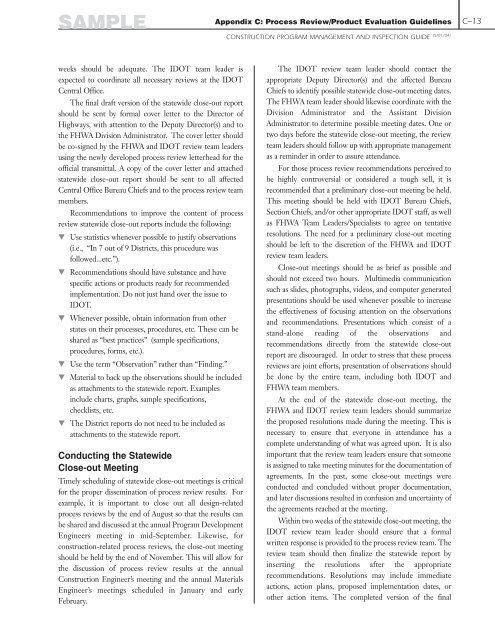Construction Program Management and Inspection Guide
Construction Program Management and Inspection Guide
Construction Program Management and Inspection Guide
You also want an ePaper? Increase the reach of your titles
YUMPU automatically turns print PDFs into web optimized ePapers that Google loves.
SAMPLE<br />
weeks should be adequate. The IDOT team leader is<br />
expected to coordinate all necessary reviews at the IDOT<br />
Central Office.<br />
The final draft version of the statewide close-out report<br />
should be sent by formal cover letter to the Director of<br />
Highways, with attention to the Deputy Director(s) <strong>and</strong> to<br />
the FHWA Division Administrator. The cover letter should<br />
be co-signed by the FHWA <strong>and</strong> IDOT review team leaders<br />
using the newly developed process review letterhead for the<br />
official transmittal. A copy of the cover letter <strong>and</strong> attached<br />
statewide close-out report should be sent to all affected<br />
Central Office Bureau Chiefs <strong>and</strong> to the process review team<br />
members.<br />
Recommendations to improve the content of process<br />
review statewide close-out reports include the following:<br />
▼ Use statistics whenever possible to justify observations<br />
(i.e., “In 7 out of 9 Districts, this procedure was<br />
followed...etc.”).<br />
▼ Recommendations should have substance <strong>and</strong> have<br />
specific actions or products ready for recommended<br />
implementation. Do not just h<strong>and</strong> over the issue to<br />
IDOT.<br />
▼ Whenever possible, obtain information from other<br />
states on their processes, procedures, etc. These can be<br />
shared as “best practices” (sample specifications,<br />
procedures, forms, etc.).<br />
▼ Use the term “Observation” rather than “Finding.”<br />
▼ Material to back up the observations should be included<br />
as attachments to the statewide report. Examples<br />
include charts, graphs, sample specifications,<br />
checklists, etc.<br />
▼ The District reports do not need to be included as<br />
attachments to the statewide report.<br />
Conducting the Statewide<br />
Close-out Meeting<br />
Timely scheduling of statewide close-out meetings is critical<br />
for the proper dissemination of process review results. For<br />
example, it is important to close out all design-related<br />
process reviews by the end of August so that the results can<br />
be shared <strong>and</strong> discussed at the annual <strong>Program</strong> Development<br />
Engineers meeting in mid-September. Likewise, for<br />
construction-related process reviews, the close-out meeting<br />
should be held by the end of November. This will allow for<br />
the discussion of process review results at the annual<br />
<strong>Construction</strong> Engineer’s meeting <strong>and</strong> the annual Materials<br />
Engineer’s meetings scheduled in January <strong>and</strong> early<br />
February.<br />
Appendix C: Process Review/Product Evaluation <strong>Guide</strong>lines<br />
CONSTRUCTION PROGRAM MANAGEMENT AND INSPECTION GUIDE (5/01/04)<br />
The IDOT review team leader should contact the<br />
appropriate Deputy Director(s) <strong>and</strong> the affected Bureau<br />
Chiefs to identify possible statewide close-out meeting dates.<br />
The FHWA team leader should likewise coordinate with the<br />
Division Administrator <strong>and</strong> the Assistant Division<br />
Administrator to determine possible meeting dates. One or<br />
two days before the statewide close-out meeting, the review<br />
team leaders should follow up with appropriate management<br />
as a reminder in order to assure attendance.<br />
For those process review recommendations perceived to<br />
be highly controversial or considered a tough sell, it is<br />
recommended that a preliminary close-out meeting be held.<br />
This meeting should be held with IDOT Bureau Chiefs,<br />
Section Chiefs, <strong>and</strong>/or other appropriate IDOT staff, as well<br />
as FHWA Team Leaders/Specialists to agree on tentative<br />
resolutions. The need for a preliminary close-out meeting<br />
should be left to the discretion of the FHWA <strong>and</strong> IDOT<br />
review team leaders.<br />
Close-out meetings should be as brief as possible <strong>and</strong><br />
should not exceed two hours. Multimedia communication<br />
such as slides, photographs, videos, <strong>and</strong> computer generated<br />
presentations should be used whenever possible to increase<br />
the effectiveness of focusing attention on the observations<br />
<strong>and</strong> recommendations. Presentations which consist of a<br />
st<strong>and</strong>-alone reading of the observations <strong>and</strong><br />
recommendations directly from the statewide close-out<br />
report are discouraged. In order to stress that these process<br />
reviews are joint efforts, presentation of observations should<br />
be done by the entire team, including both IDOT <strong>and</strong><br />
FHWA team members.<br />
At the end of the statewide close-out meeting, the<br />
FHWA <strong>and</strong> IDOT review team leaders should summarize<br />
the proposed resolutions made during the meeting. This is<br />
necessary to ensure that everyone in attendance has a<br />
complete underst<strong>and</strong>ing of what was agreed upon. It is also<br />
important that the review team leaders ensure that someone<br />
is assigned to take meeting minutes for the documentation of<br />
agreements. In the past, some close-out meetings were<br />
conducted <strong>and</strong> concluded without proper documentation,<br />
<strong>and</strong> later discussions resulted in confusion <strong>and</strong> uncertainty of<br />
the agreements reached at the meeting.<br />
Within two weeks of the statewide close-out meeting, the<br />
IDOT review team leader should ensure that a formal<br />
written response is provided to the process review team. The<br />
review team should then finalize the statewide report by<br />
inserting the resolutions after the appropriate<br />
recommendations. Resolutions may include immediate<br />
actions, action plans, proposed implementation dates, or<br />
other action items. The completed version of the final<br />
C–13

















